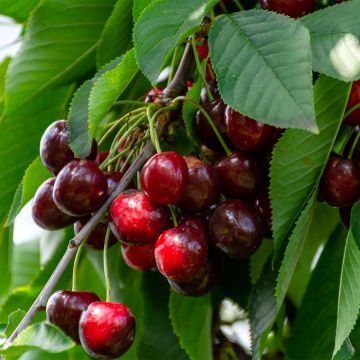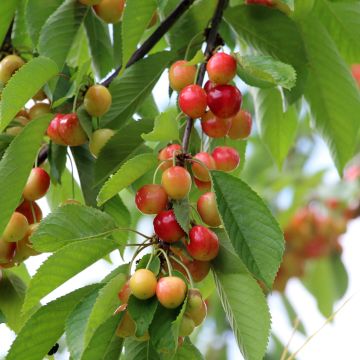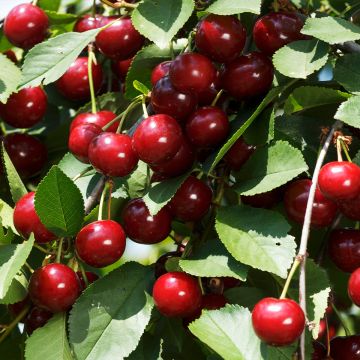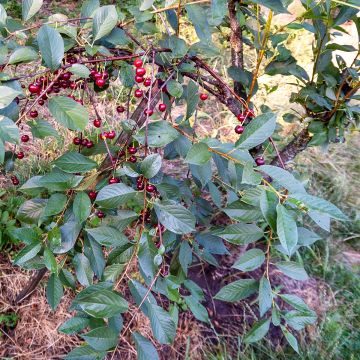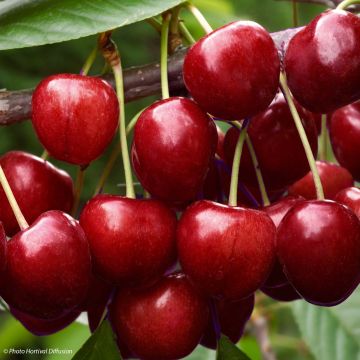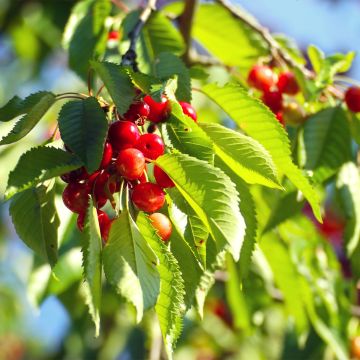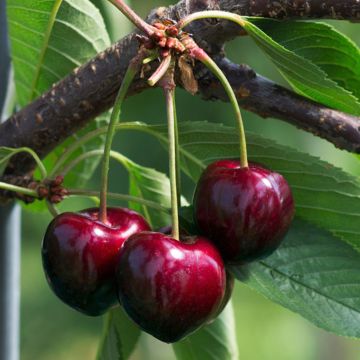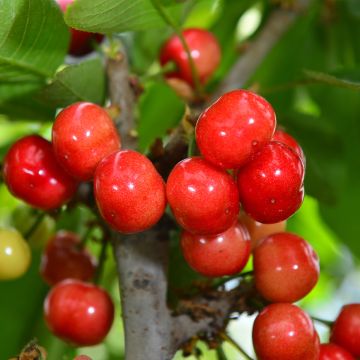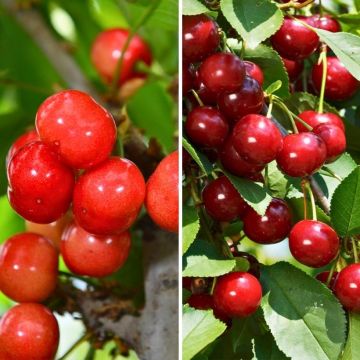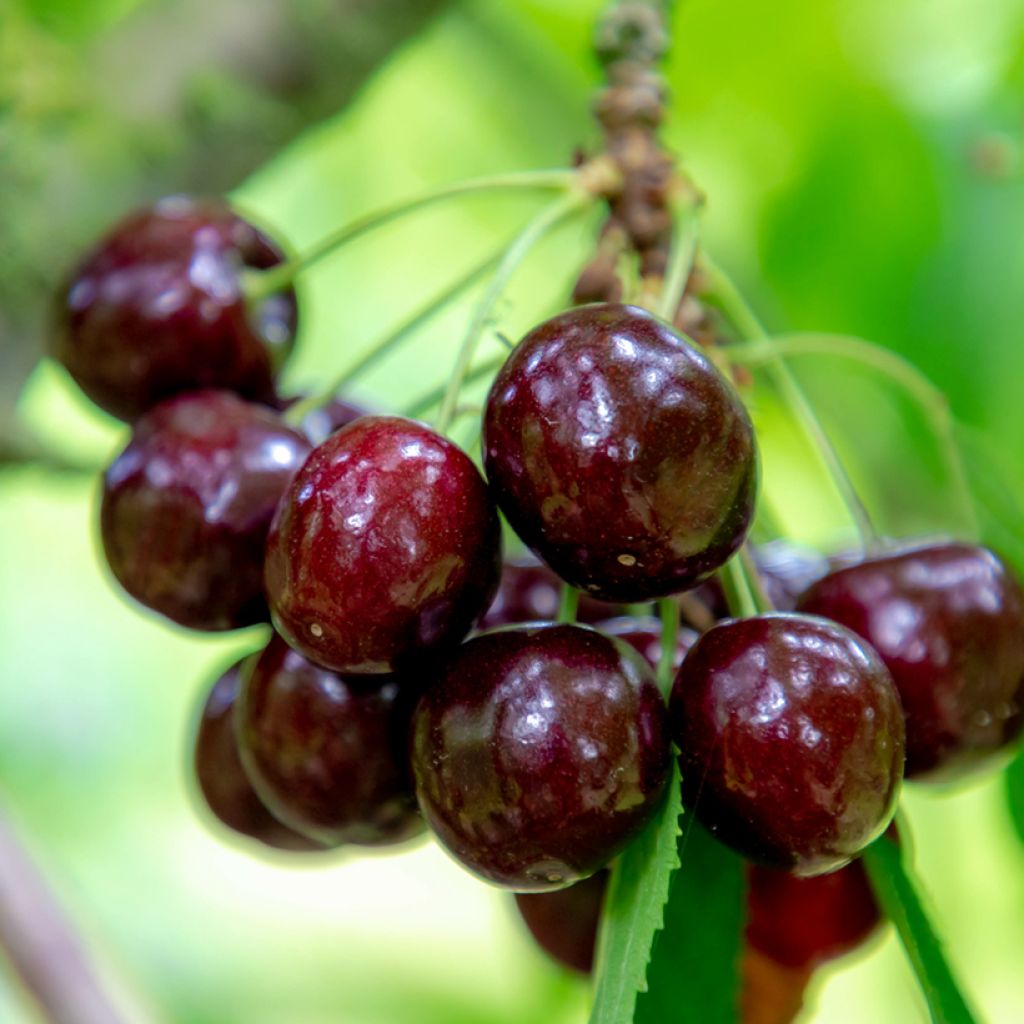

Prunus avium Kordia- Cherry Tree
Prunus avium Kordia- Cherry Tree
Prunus avium Kordia
Wild Cherry, Sweet Cherry
This item cannot be shipped to the selected country
Oversize package delivery charge from €6.90
Delivery to Corse prohibited
More information
Schedule delivery date,
and select date in basket
This plant carries a 6 months recovery warranty
More information
We guarantee the quality of our plants for a full growing cycle, and will replace at our expense any plant that fails to recover under normal climatic and planting conditions.
Oversize package: home delivery by special carrier from €6.90 per order..
Express home delivery from €8.90.
Delivery to Corse prohibited: UE law prohibits the import of this plant from mainland France to Corse as part of the fight against Xylella fastidiosa. Please accept our sincere apologies.
More information
Description
The Kordia cherry tree, in Latin Prunus avium 'Kordia', is a late variety, yet productive, highly valued for its large dark red cherries of excellent quality. Originating from Czechoslovakia, this variety has been cultivated in Europe since 1992. Its fruits are firm, juicy, crunchy, not very prone to splitting, and they hold well on the tree. 'Kordia' offers a beautiful spring flowering and a generous harvest in July. Its cherries are well distributed on the branches, carried by a long peduncle and easy to pick. This cherry tree is not self-fertile, choose 'Hedelfingen' or 'Summit' as pollinators.
The 'Kordia' cherry tree comes from a chance seedling in 1963 in Techlovie, Czechoslovakia. This deciduous tree, of medium vigour, has a semi-spreading habit, although sometimes prone to thinning. It bears fruit quite rapidly for a cherry tree. At maturity, it generally reaches a height of 4 to 5 m, rarely 6 to 7 m. Its leaves are dark green, and its white flowers appear late in April, around 8 days after those of the 'Bigarreau Burlat'. 'Kordia' cherries are harvested between late June and July, 25 to 26 days after 'Burlat'. They are large (9 to 12 g), heart-shaped, with dark red skin and a long peduncle. They are juicy, crunchy and aromatic, but slightly astringent if harvested too early. This cherry tree thrives in rich, well-drained soils. It is quite resistant to fruit splitting, but its flowering is sensitive to spring frosts. 'Kordia' shows good performance in all regions.
The Cherry tree, in Latin Prunus avium, belongs to the large Rosaceae family, which includes most fruit trees, as well as many ornamental plants. It is a medium-sized tree, reaching 5 to 10 m in height at maturity. Its rounded habit provides beautiful shade, very pleasant during the summer. Its alternate, toothed leaves are shiny and dark green, turning a lovely reddish hue in autumn before falling. Cherries are rich in vitamin C, minerals, and trace elements.
This 'Kordia' cherry tree is not self-fertile, it requires pollination by another tree, choose a variety from among the following: 'Fermina', 'Hedelfingen', 'Summit', 'Régina', 'Noir de Meched', 'Belge', 'Badacsony' or 'Sunburst' (Profile S3S6).
The cherry tree grows well in most soils, provided it does not lack water too much in summer. It even appreciates some humidity if the soil is well-drained and thrives in full sun. The flowers can be damaged by spring frosts, so it is a good idea to plant cherry trees in a sheltered, west-facing location, protected from cold winds in regions that experience quite significant late frosts. However, the very abundant flowering still often results in satisfactory fruiting. The cherry tree is a charming small tree, delicious, ornamental, largely disease-resistant, and almost maintenance-free. It can be planted on a lawn, at the back of a border, or within an orchard, combined with apple trees, pear trees, plum trees ...
Report an error about the product description
Plant habit
Fruit
Flowering
Foliage
Botanical data
Prunus
avium
Kordia
Rosaceae
Wild Cherry, Sweet Cherry
Cultivar or hybrid
Other Cherry trees
Planting and care
The 'Kordia' cherry tree grows in any type of deep soil, slightly acidic to slightly chalky. It appreciates moist, light soils and dislikes heavy, sticky, very clayey soils. Choose a sunny exposure. To limit the risks of late frosts on the flowers, it is recommended to plant the Cherry Tree in a sheltered position, facing west and protected from cold winds in regions experiencing spring frosts. Planting is preferably done in autumn. If you plant several plants, space them 4 to 5 m apart for goblet trees.
Loosen the soil deeply, remove stones and unwanted weeds. Add some sand to improve drainage. Dig a hole 4 to 5 times the volume of the root ball. Make sure to set aside the subsoil and the topsoil separately. Mix crushed horn or well-rotted compost or potting soil with the subsoil and pour this mixture into the planting hole. Install a stake. Place the root ball, cover with the topsoil, and firm down. Water generously (around 20 L). Tie the stake to the plant, crossing the tie in a figure-of-eight, without touching the trunk.
Watering is not necessary except in case of intense heat. Mulch at the base to retain moisture in summer. Protect your harvest by installing a bird-proof net, aluminium foil or old CDs. In case of aphid infestation, spray water mixed with black soap. To combat cherry fruit fly, set up sticky cardboard traps or pheromone traps as soon as the cherries form on the tree.
Planting period
Intended location
Care
This item has not been reviewed yet - be the first to leave a review about it.
Haven't found what you were looking for?
Hardiness is the lowest winter temperature a plant can endure without suffering serious damage or even dying. However, hardiness is affected by location (a sheltered area, such as a patio), protection (winter cover) and soil type (hardiness is improved by well-drained soil).

Photo Sharing Terms & Conditions
In order to encourage gardeners to interact and share their experiences, Promesse de fleurs offers various media enabling content to be uploaded onto its Site - in particular via the ‘Photo sharing’ module.
The User agrees to refrain from:
- Posting any content that is illegal, prejudicial, insulting, racist, inciteful to hatred, revisionist, contrary to public decency, that infringes on privacy or on the privacy rights of third parties, in particular the publicity rights of persons and goods, intellectual property rights, or the right to privacy.
- Submitting content on behalf of a third party;
- Impersonate the identity of a third party and/or publish any personal information about a third party;
In general, the User undertakes to refrain from any unethical behaviour.
All Content (in particular text, comments, files, images, photos, videos, creative works, etc.), which may be subject to property or intellectual property rights, image or other private rights, shall remain the property of the User, subject to the limited rights granted by the terms of the licence granted by Promesse de fleurs as stated below. Users are at liberty to publish or not to publish such Content on the Site, notably via the ‘Photo Sharing’ facility, and accept that this Content shall be made public and freely accessible, notably on the Internet.
Users further acknowledge, undertake to have ,and guarantee that they hold all necessary rights and permissions to publish such material on the Site, in particular with regard to the legislation in force pertaining to any privacy, property, intellectual property, image, or contractual rights, or rights of any other nature. By publishing such Content on the Site, Users acknowledge accepting full liability as publishers of the Content within the meaning of the law, and grant Promesse de fleurs, free of charge, an inclusive, worldwide licence for the said Content for the entire duration of its publication, including all reproduction, representation, up/downloading, displaying, performing, transmission, and storage rights.
Users also grant permission for their name to be linked to the Content and accept that this link may not always be made available.
By engaging in posting material, Users consent to their Content becoming automatically accessible on the Internet, in particular on other sites and/or blogs and/or web pages of the Promesse de fleurs site, including in particular social pages and the Promesse de fleurs catalogue.
Users may secure the removal of entrusted content free of charge by issuing a simple request via our contact form.
The flowering period indicated on our website applies to countries and regions located in USDA zone 8 (France, the United Kingdom, Ireland, the Netherlands, etc.)
It will vary according to where you live:
- In zones 9 to 10 (Italy, Spain, Greece, etc.), flowering will occur about 2 to 4 weeks earlier.
- In zones 6 to 7 (Germany, Poland, Slovenia, and lower mountainous regions), flowering will be delayed by 2 to 3 weeks.
- In zone 5 (Central Europe, Scandinavia), blooming will be delayed by 3 to 5 weeks.
In temperate climates, pruning of spring-flowering shrubs (forsythia, spireas, etc.) should be done just after flowering.
Pruning of summer-flowering shrubs (Indian Lilac, Perovskia, etc.) can be done in winter or spring.
In cold regions as well as with frost-sensitive plants, avoid pruning too early when severe frosts may still occur.
The planting period indicated on our website applies to countries and regions located in USDA zone 8 (France, United Kingdom, Ireland, Netherlands).
It will vary according to where you live:
- In Mediterranean zones (Marseille, Madrid, Milan, etc.), autumn and winter are the best planting periods.
- In continental zones (Strasbourg, Munich, Vienna, etc.), delay planting by 2 to 3 weeks in spring and bring it forward by 2 to 4 weeks in autumn.
- In mountainous regions (the Alps, Pyrenees, Carpathians, etc.), it is best to plant in late spring (May-June) or late summer (August-September).
The harvesting period indicated on our website applies to countries and regions in USDA zone 8 (France, England, Ireland, the Netherlands).
In colder areas (Scandinavia, Poland, Austria...) fruit and vegetable harvests are likely to be delayed by 3-4 weeks.
In warmer areas (Italy, Spain, Greece, etc.), harvesting will probably take place earlier, depending on weather conditions.
The sowing periods indicated on our website apply to countries and regions within USDA Zone 8 (France, UK, Ireland, Netherlands).
In colder areas (Scandinavia, Poland, Austria...), delay any outdoor sowing by 3-4 weeks, or sow under glass.
In warmer climes (Italy, Spain, Greece, etc.), bring outdoor sowing forward by a few weeks.


































